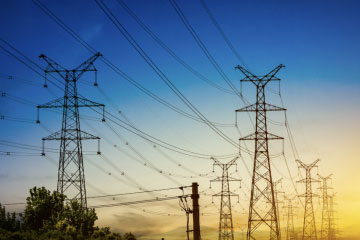List of Special Sessions(closed)
|
SS
ID: |
SS01 |
|
Topic: |
Mechanical
Behaviors and Applications of Advanced Materials and Structures |
|
Organizer(s): |
Jia-Jia
Mao, Beijing University of Technology Xiangying
Guo, Beijing University of Technology Jing
Liu, Huazhong Agricultural University |
|
Description: |
Advanced
materials and structures is promising to foster innovation, drive sustainable
development, and reshape the landscape of engineering by creating solutions
that transcend traditional limitations and contribute to the evolution of
cutting-edge technologies. This special session aims to provide a platform
for researchers, academics, and industry professionals to exchange knowledge,
share advancements, and foster collaboration in the mechanical behaviors of
advanced materials and structures, and bridge the gap between theoretical
advancements and their real-world impact on engineering structures.
Submissions are encouraged in, but not limited in the following topics: ·
Functionally
Graded Materials ·
Smart
Materials and Structures ·
Metamaterials
Design ·
Intelligent
Broadband Vibration Reduction and Isolation ·
Energy
Conversion and Vibration Energy Harvesting |
|
SS
ID: |
SS02 |
|
Topic: |
Decarbonising
Building Structures Using Renewable Materials |
|
Organizer(s): |
Benoit
Gilbert, Griffith University Hong
Guan, Griffith University |
|
Description: |
With
37% of the world energy-related CO2 emissions produced by the construction
industry, decarbonising building structures is essential for not only
mitigating climate change but also promoting healthier, more resilient, and
economically vibrant communities. It represents a crucial step towards
achieving sustainable development and securing a better future for
generations to come. Consequently, most developed and developing nations have
recognised the importance of addressing emissions from buildings and have
taken steps to implement relevant policies. This
special session proposes a forum where experts, junior researchers, industry
leaders and PhD candidates can discuss and present the latest innovations and
materials to decarbonise our built environment. The session is organised by
members of the newly established Decarbonise Building Industry international
research network. The session includes but is not restricted to
carbon-neutral materials and load bearing systems, sustainable construction
techniques, life cycle assessment, environmentally responsive structures, and
relevant policies. |
|
SS
ID: |
SS03 |
|
Topic: |
Building
Information Modelling (BIM) and Engineering Structures |
|
Organizer(s): |
Ke
Li, China State Construction Technical Center Chen
Liu, China State Construction Technical Center |
|
Description: |
The
BIM technology is treated as the foundation of digitization and intelligence
of the AEC (Architecture, Engineering and Construction) industry, and the
application of BIM has the potential to significantly improve the efficiency
and quality of engineering structure design, analysis, and optimization. The
proposed SS is aiming at discussing the latest innovations, achievements and
current trends in the fields of BIM-based information collection, data
analysis, work collaboration, and result display for engineering structures. |
|
SS
ID: |
SS04 |
|
Topic: |
Design
Strategies for Improving the Dynamic Performance of Offshore Wind Turbine
Systems |
|
Organizer(s): |
Hao
Ding, The Hong Kong Polytechnic University Okyay
Altay, RWTH Aachen University Jinting
Wang, Tsinghua University |
|
Description: |
Offshore
wind turbines operate in a harsh marine environment with complex wave, wind,
and structure interactions. The dynamic loads imposed on the turbine
structure can lead to fatigue damage, structural degradation, and reduced
system reliability over time. In general, the design and analysis of
high-rise and flexible wind turbine structures require consideration of
multiple interacting dynamic effects, including aerodynamics, hydrodynamics,
servo systems, soil mechanics, and structural dynamics. Comprehensive design
strategies that include all the crucial dynamic effects should be explored to
improve dynamic performance of the turbine system, which helps ensure the
structural integrity and long-term reliability, thereby reducing the risk of
costly repairs and downtime. This special session aims to generate a platform
for the dissemination of the state-of-the-art and state-of-the-practice in this
active research field and bridge the knowledge gaps across disciplines. |
|
SS
ID: |
SS05 |
|
Topic: |
Energy
Absorption of Advanced Materials and Structures |
|
Organizer(s): |
Xinmei
Xiang, Guangzhou University Xin
Zhang, Southern University of Science and Technology Shiqiang
Li, Taiyuan University of Technology |
|
Description: |
This
session focuses on the way in which structures and materials can be best
designed to absorb energy in a controllable and predictable manner. Advanced
structures with optimized geometrical designs and material selections could
outperform conventional uniform structures in terms of energy absorption
capacity. Advanced geometrical configuration could reduce the initial peak
load as well as increase the mean crushing load, which provides the structure
the possibility to collapse in a more controlled manner and have a remarkable
energy-absorbing efficiency. The materials have wide-challenging properties
such as viscoelastic behavior, deformation behavior, and damage initiation
and propagation mechanisms, which are important in assessing the mechanical
properties of the structure. The advanced materials could be used in
multi-purpose applications with their flexibility, energy absorption, and
possibility of utilizing in new fabrication methods such as 3D printing. |
|
SS
ID: |
SS06 |
|
Topic: |
Graphene
Reinforced High-performance and Multifunctional Composite Structures |
|
Organizer(s): |
Chuang
Feng, Nanjing Technology University Helong
Wu, Zhejiang University of Technology Zhicheng
Yang, Zhongkai University of Agriculture and Engineering |
|
Description: |
Due
to the possession of excellent mechanical and physical properties, graphene
and its derivatives have attracted great attention as reinforcing fillers for
various matrices in developing high-performance and multifunctional
composites and structures. It is evidenced that a small amount of the fillers
added into matrix can considerably enhance the performances of the
composites. Apart from serving as high-performance structural materials,
graphene reinforced composites (GRCs) can be used as smart self-sensing
materials and metamaterials by utilizing their physical properties, such as
electrical conductivity, piezoresistivity and electromagnetic properties,
negative Poison’s ratio and thermal expansion. The experiments as well as
theoretical work on characterizing and predicting these properties are
essential for the practical engineering applications of these multifunctional
GRC.
SCOPE: Interested
topics including, but not limited to: 1.
GRC-based metamaterials; 2.
GRC-based smart materials and structures; 3.
Piezoresistivity/thermoelectric/electromagnetic/mechanical properties of
GRCs; 4.
Modelling and simulation on predicting the performances of GRCs; 5.
Experimental investigation on characterizing the performances of GRCs. |
|
SS
ID: |
SS07 |
|
Topic: |
Multi-scale
Dynamic Behavior and Design Principle of Fiber Composite Structures |
|
Organizer(s): |
Pengfei
Wang, University of Science and Technology of China Xin
Li, Nanjing University of Science and Technology Xin
Zhang, Southern University of Science and Technology |
|
Description: |
Fiber
composite materials/structures play an important role in aerospace, automobile,
infrastructure and other engineering field. However, these composite
structures may face the threat of external high-velocity impact, such as car
collision, bird strike, and seismic loading, etc., which lay a hidden danger
for the safety of these composites. Nowadays, multi-scale dynamic experiments
and design principle of composite structures are still a big challenge owing
to the complex composition and structural forms. Dynamic damage evolution
mechanism, interface delamination criteria, and strain rate effect of
fiber-reinforced composite materials/structures are still hot issues. It is
necessary to fully understand the dynamic deformation mechanism of fiber
composite structures for designing and repairing the microstructural
configurations of composites. Thus, we hope to organize this Special Session
to discuss the latest research progress in multi-scale dynamic behavior and
design principle of fiber composite structures
|
|
SS
ID: |
SS08 |
|
Topic: |
Machine
Learning -based Structural Analysis and Optimization |
|
Organizer(s): |
Sawekchai
Tangaramvong, Chulalongkorn University Wenxiong
Li, South China Agricultural University Wei
Gao, The University of New South Wales |
|
Description: |
This
special session addresses state-of-the-art machine learning (ML)-based
methods developed in the analysis and optimal design applications of
engineering structures. Based on the set of input-output data collection, the
ML approach constructs a so-called surrogate-assisted model that can provide
the response prediction of specified dataset. The technique, in view of its
computational advantage in bypassing conventional analysis procedures, has
supported the fast-growing research discoveries, involving the implementation
of complex nonlinear responses in engineering mechanics applications. The ML
methods have been not only applied with metaheuristic algorithms under
deterministic structural optimization, but also to perform the failure
probability approximation under indeterministic analysis and design of
structures. The areas of interest, but-not-limited-to, encompass nonlinear
structural optimization, elastoplastic analysis of engineering structures,
parametric identification, static and dynamic response prediction, structural
damage detection and health monitoring, reliability analysis and design, etc.
|
|
SS
ID: |
SS09 |
|
Topic: |
Advancing Modular
Construction: Innovations, Design, Construction, and Sustainability |
|
Organizer(s): |
Zhenyu Huang, Shenzhen
University Kai Leung Su, The University of Hong Kong Chao Hou, Southern University
of Science and Technology Jiadi Liu, Tianjin
University Enfeng Deng, Zhengzhou
University Liang Zong, Tianjin
University |
|
Description: |
The
Mini-Symposia/Special Session on " Advancing Modular Construction:
Innovations, Design, Construction, and Sustainability" aims to spotlight
the latest developments and innovative methodologies in the field of Modular
Integrated Construction across Singapore (PPVC), Hong Kong (MiC) and Mainland
China (Modular Constructions). This session will provide a comprehensive
platform to invite Young Professors and industry experts for discussing the
integration of prefabricated modules in the construction of various
engineering structures, focusing on low carbon material, modular systems,
efficiency, sustainability, and technological advancements and cost
effectiveness. Industry experts and research scholars will present innovative
modular systems, Transportation, Construction Technology, Analysis,
Standards, & Code of Practice, case studies and technological
breakthroughs that highlight the benefits and challenges associated with
modular construction, including reduced construction times,
cost-effectiveness, environmental impact, and the role of digital
technologies in enhancing precision and quality. The session seeks to foster
a deeper understanding of the current trends, future prospects, and practical
applications of modular construction in engineering, encouraging
collaboration and knowledge exchange among professionals, researchers, and
industry stakeholders. |
|
SS
ID: |
SS10 |
|
Topic: |
Nonlinear Dynamics of
Engineering Structures |
|
Organizer(s): |
Chaoran Liu, Beijing
University of Technology Jiaxi Zhou, Hunan
University Xiaodong Yang, Beijing
University of Technology |
|
Description: |
Nonlinearity can be
exploited to enhance the performances of engineering structures. Examples of
intentional nonlinear designs in engineering structures include nonlinear
vibration isolators, nonlinear vibration absorbers, nonlinear energy
harvesters, etc. Besides, inherent nonlinear property may also arise when
engineering structures experience large deformation or large displacement.
The intentional or inherent nonlinearity makes engineering structures exhibit
complicated dynamic behaviors such as super-/sub-harmonic resonances, chaos,
and bifurcations. This special session aims to provide a platform for
scholars to disseminate and discuss the latest research progress on nonlinear
dynamics of engineering structures. Submissions are encouraged in, but not
limited to, the following topics: |
|
SS
ID: |
SS11 |
|
Topic: |
Concrete Filled Steel
Tubular Structures |
|
Organizer(s): |
Hua Yang, Harbin
Institute of Technology Wei Li, Tsinghua
University Chuan-Chuan Hou, Beihang
University |
|
Description: |
Concrete-filled steel
tubular (CFST) structures have been widely adopted in super-tall buildings,
large-span bridges, and large-scale energy projects, etc., due to their
competitive mechanical properties. They have emerged as a superior structural
type for the main structures in modern major constructions. Recently,
extensive innovative research has been conducted to explore the mechanical
excellence of CFST, discover new possibilities in various sectors, and meet
the diverse demands of contemporary infrastructure. Therefore, this special
session aims to present the latest ideas, theories, numerical modeling and
tests, design, and applications of CFST structures. It also serves as a
platform for interested researchers to exchange future research topics and
facilitate potential collaborations. |
|
SS
ID: |
SS12 |
|
Topic: |
Advanced concrete
technology and composite structures |
|
Organizer(s): |
F.M. Ren, Guangzhou
University J.C.M. Ho, University
of Queensland Z.W. Yu, Guangzhou
University M.H. Lai, Guangzhou
University |
|
Description: |
The symposium explores
the forefront of innovation and application in civil engineering materials.
Highlighting the latest developments, this symposium brings together
researchers, practitioners, and industry professionals to delve into the
intricate realm of concrete technology and composite structures. Topics
include novel materials, sustainable design for concrete to mitigate carbon
footprint, structural performance of sustainable concrete-composite
structure, and advanced construction methodologies. Through interdisciplinary
discussions and case studies, participants will uncover the challenges and
opportunities in enhancing durability, resilience, and sustainability in
infrastructure. This symposium serves as a platform for knowledge exchange,
fostering collaboration and driving forward the evolution of concrete
technology and composite structures to meet the demands of our ever-changing
built environment. |
|
SS
ID: |
SS13 |
|
Topic: |
Damage Identification
Under Changing Environmental and Operational Conditions in Structural Health Monitoring |
|
Organizer(s): |
Dongsheng Li, Shantou
University Jiezhong Huang, Shantou
University Hongnan Li, Dalian
University of Technology |
|
Description: |
Structural health
monitoring (SHM) has received considerable attention for the last two
decades. Regarding the broad industrial application of different approaches,
the “problem” is the ability to detect, locate
and assess the extent of damages in a real structure in-situ so that its
remaining life can be known and possibly extended. However, an SHM system for
in-situ or in-service structures poses many significant technical challenges.
One of the main obstacles is the environmental and operational variation of
structures. In fact, these changes can often mask subtler structural changes
caused by damage. In the most of cases the so-called damage-sensitive
features employed in conventional damage detection techniques are also
sensitive to changes in environmental and operational conditions (EOC) of
structures. Therefore, we solicit papers that at one hand shows the
influences of EOC on damage identification and the limitation of existing
approaches. On the other hand we need papers presenting new technologies to
remove the EOC effects on damage sensitive features, damage indicators or
damage identification approaches. At the same time, we are looking for papers
presenting EOC-insensitive features extracted from monitoring data of
structures in-situ.. Other research about data analysis and signal processing
techniques w.r.t to structures under EOC-influences is also welcomed. We
expect submissions addressing any of these challenges. |
|
SS
ID: |
SS14 |
|
Topic: |
Shape Memory
Alloy-based Passive Seismic Protection Technologies for Resilient Structural
Design |
|
Organizer(s): |
Fei Shi, Guangzhou
University Cheng Fang, Tongji
University Osman E. Ozbulut, University
of Virginia |
|
Description: |
Resilience-based
design has emerged as an extension of performance-based design since the
introduction of a framework to quantitatively assess seismic resilience. The
typical characteristics of seismically resilient structures include the
ability to resist and minimize damage, the ability to maintain key
functionality throughout an earthquake, and the ability to rapidly recover to
the target operational level after such an event. One of the promising
strategies for the resilient design of civil structures is the use of shape
memory alloys (SMAs)-based seismic protection systems. SMAs are a class of
smart metals that exhibit several peculiar properties, such as the ability to
experience large, nonlinear deformations but fully recover these deformations
upon the removal of the loading. Although SMAs have been considered for
various civil engineering applications, the most promising and widely studied
application of SMAs is their use in seismic protection systems, such as
dampers, bracing systems, and isolation bearings. This session aims to
explore the latest research developments related to the application of SMAs
in passive seismic control systems and create a platform to discuss
challenges in technology transfer, future prospects, and practical
applications of SMA-based seismic protection technologies. |
|
SS
ID: |
SS15 |
|
Topic: |
Metallic and
Bimetallic Structures for Long-life Service |
|
Organizer(s): |
Huiyong Ban, Tsinghua
University KF Chung, The Hong
Kong Polytechnic University Zhongxing Wang,
Tianjin University |
|
Description: |
Innovation in
structural materials has always been one of the most important ways to
address the challenges of contemporary structural engineering. Various kinds
of advanced metals and bimetals are developed, and getting increasing
attention from the academic community as they possess both high mechanical
and service performance, such as high-strength aluminium alloy, stainless
steel, titanium alloy and bimetallic steel with two different metals being
metallurgically bonded together. These structural-functional integration
materials can provide ideal design solutions for long-life structures against
corrosion, fatigue, etc. However, their unique material properties and
fabrication techniques make the structural performance special, and thus
innovative research work and findings are in need. |
|
SS
ID: |
SS16 |
|
Topic: |
Recycled aggregate
concrete structures and components |
|
Organizer(s): |
Yuxi Zhao, Zhejiang
University Yue Geng, Harbin
Institute of Technology Haiyan Zhang, South
China University of Technology Zhenhua Duan, Tongji
University |
|
Description: |
The construction
industry has increasingly prioritized sustainability and eco-friendly
practices, with the utilization of Recycled Aggregate Concrete (RAC)
structures emerging as a notable trend. Embracing RAC structures offers a
multitude of benefits, including a reduced carbon footprint, preservation of
natural resources, and cost-effectiveness. In recent years, RAC structures
have garnered significant attention for their potential to foster sustainable
development within the construction sector. However, while much research has
focused on the material properties of RAC, there remains a need for further
exploration into the performance of RAC components and structures to
effectively apply them in concrete projects. This special session aims to
address this gap by providing a platform to discuss the latest advancements,
challenges, and applications of using RAC in structures. |
|
SS
ID: |
SS17 |
|
Topic: |
Bayesian System Identification
and Structural Health Monitoring of Engineering Structures: Algorithms,
Machine Learning Methods and Applications |
|
Organizer(s): |
Heung-Fai Lam, City
University of Hong Kong Jia-Hua Yang, Guangxi
University Jun Hu, Wuhan
University of Technology |
|
Description: |
Significant effort has
been devoted to modeling and identification of engineering structural systems
based on measured data to understand and predict structural behaviors.
Structural health monitoring (SHM) employs system identification and other
technologies to monitor and assess various structures, aiming at ensuring
structural safety, reducing maintenance costs and extending lifespan.
However, engineering structural systems are typically non-linear, high-dimensional
and complex. Identifying these systems based only on physics principles is
challenging, and sometimes the identified systems cannot accurately reflect
actual structural behaviors. Moreover, extracting interpretable information
from monitoring data is difficult.
Vast quantities of available data, large computational power and rapid
development of machine learning methods are revolutionizing system
identification and SHM of engineering structures. Machine learning methods
can bring together traditional system identification methods, knowledge of
physics and data to augment modeling and identification of engineering
structural systems. They can also provide a new framework for discovering
hidden governing physical principles in data of SHM for interpreting the data
and extracting information for assessing and predicting structural
performance. |







